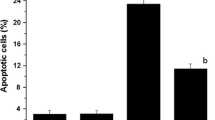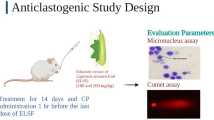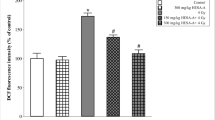Abstract
Nordihydroguaiaretic acid (NDGA), a phenolic lignan, was tested for its antigenotoxic potential against chlormadinone acetate (CMA)-induced genotoxic damage in mice bone-marrow cells. Doses of about 22.50 mg/kg body weight of CMA were given along with 1, 5 and 10 mg/kg body weight of NDGA intraperitoneally. The treatment resulted in the reduction of sister chromatid exchanges and chromosomal aberrations induced by CMA, suggesting an antigenotoxic potential of NDGA. Earlier studies show that CMA generates reactive oxygen species, responsible for genotoxic damage. The free radical-scavenging property of NDGA is responsible for the reduction of genotoxic damage induced by CMA in mice bone-marrow cells.
Similar content being viewed by others
Avoid common mistakes on your manuscript.
Introduction
Nordihydroguaiaretic acid (NDGA) is a phenolic lignan present in the evergreen shrubs Larrea divaricata and Guaiacum officinale (Fig. 1) [1]. NDGA possesses a number of interesting biological properties which are of potential use to humans such as enzyme inhibition [2], antimicrobial properties [3], protection from neurotoxicity and bladder toxicity [4, 5], stimulation of the corpus luteum for the secretion of progesterone [6], potential vaso- and bronchodilation [7], and anti-apoptotic [8], estrogenic [9], antimutagenic [10] and anti-cancer [11] properties. NDGA has also been reported to possess both genotoxic [12] and anti-genotoxic potential [13] in vivo and in vitro. Chlormadinone acetate (CMA), a synthetic progestin, has been reported to induce genotoxic damage in both in vivo [14] and in vitro studies [15]. In the present study, the effect of NDGA was studied on the frequencies of chromosomal aberrations (CAs) and sister chromatid exchanges (SCEs) induced by CMA in mouse bone-marrow cells.
Materials and methods
Chemicals
NDGA (CAS no.: 500-38-9, Fluka), CMA (CAS no.: 302-22-7, Sigma), Hoechst 33258 stain (0.05% w/v), N-methyl-N′-nitro-N-nitroso-guanidine (1.2 × 104 μg/kg body weight) and 5-bromo-2-deoxyuridine (1.6 g/kg body weight) were purchased from Sigma. Giemsa solution (5 and 7%) in phosphate buffer (pH 6.8) and DMSO (0.1 ml/animal) were purchased from E. Merck, India.
Animals
Swiss albino female mice (Mus musculus L.), 25–30 g and 10–12 weeks old, were procured from Lucknow (UP), India, and grouped in different polypropylene cages (five animals per group) at a mean temperature of 25°C. Permission was granted for experimentation by the departmental ethical committee.
Analysis of sister chromatid exchanges
The fluorescent plus Giemsa technique was followed for SCEs analysis [16]. 5-Bromo-2-deoxyuridine (1.6 g/kg body weight) in tablet form was implanted subcutaneously in the neck region of each mouse under mild anaesthesia; 30 min later, CMA at 22.50 mg/kg body weight, and NDGA at 1, 5 and 10 mg/kg body weight were separately injected intraperitoneally (i.p.). DMSO and N-methyl-N′-nitro-N-nitrosoguanidine (MNNG) were used as negative and positive controls, respectively. After 21 h, the animals received an i.p. injection of colchicine (6.0 mg/kg body weight), and 3 h later, the bone marrow of both femurs was collected and stored in KCl 0.075 M at 37°C for 30 min. The supernatant was removed by centrifugation, and 5 ml of fixative (methanol:glacial acetic acid, 3:1) was added. The fixative was removed and the procedure was repeated twice. The microscope slides were prepared by air drying and were stained for 20 min in a 0.05% (w/v) Hoechst 33258 solution, rinsed with tap water and placed under a UV lamp for 90 min, and then covered with Sorensen’s buffer, pH 6.8, and stained with 5% Giemsa solution in phosphate buffer (pH 6.8) for 15 min. The SCE average was obtained from the analysis of metaphases in the second cycle of divisions. At least 60 second-division metaphases per mouse were scored to determine the frequency of SCEs. The slides were scored blindly by one scorer.
Chromosomal aberrations analysis
For the analysis of CAs, the tested and control doses were the same as described for the SCE analysis. Twenty-one hours after the treatment, the animals were injected i.p. with colchicine (6.0 mg/kg body weight), 2 h before killing. Bone-marrow preparations for the analysis of CAs in metaphase cells were obtained by the technique of Yosida and Amano [17]. The slides were stained with 7% Giemsa stain in phosphate buffer (pH 6.8). Five animals were included in each treatment group, and 100 well-spread metaphases were analysed per animal for CAs. The slides were scored blindly by one scorer.
Statistical analysis
Statistical analysis was performed by using one-way analyses of variance (ANOVA).
Results
In the SCEs analysis, a clear dose-dependent decrease in the number of SCEs per cell was observed when CMA (22.50 mg/kg body weight) was given along with different doses of NDGA (1, 5 and 10 mg/kg body weight) (Table 1). NDGA itself did not significantly increase the number of SCEs per cell at 1 mg/kg body weight but at 5 and 10 mg/kg body weight, SCEs per cell were slightly significantly different.
In CAs analysis, a dose-dependent significant decrease in the number of abnormal cells was observed when CMA (22.50 mg/kg body weight) was treated separately with three doses of NDGA (1, 5 and 10 mg/kg body weight) (Table 2). No significant increase in the number of abnormal cells was observed at 1 mg/kg body weight of NDGA but at 5 and 10 mg/kg body weight of NDGA the numbers of abnormal cells were slightly significantly different (Table 2).
Discussion
The results of the present study reveal that NDGA reduced the genotoxic damage by CMA in mouse bone-marrow cells. CMA, a synthetic progestin, is used either as a single entity drug or in combination with estrogens, such as ethinyl estradiol or mestranol in oral contraceptives [18]. Prolonged use of oral contraceptives has been reported to induce different types of cancer in both animals and humans [19–22]. The use of synthetic progestins cannot be completely eliminated, but their genotoxic effects can be reduced by the use of antioxidants [23, 24] and natural plant products [25–27]. CMA induces genotoxic effects by the generation of reactive oxygen species (ROS) in human lymphocytes in vitro [15]. In our earlier study, three doses of CMA, 5.62, 11.25 and 22.50 mg/kg body weight, were studied and the doses at 11.25 and 22.50 mg/kg of body weight were found to be genotoxic. The LD50 for CMA obtained was 90 mg/kg [14].
NDGA has an antitumor capacity which is probably related to the inhibition of lipoxygenase activity. It also inhibits cytochrome P450-dependent monoxygenases which metabolise pre-carcinogens to carcinogens [12]. The antigenotoxic activity of NDGA seems to depend on the specific mutagen involved and on its biological characteristics. Several explanations can be given for its antigenotoxic activity; one of them relates to its participation as enzyme inhibitor in the arachidonic cascade as well as in the P450-dependent monooxygenases. This inhibition may eliminate the bioactivation of promutagens acting in this way. A second property of NDGA is its phenolic structure, which relates to its antioxidant action, as well as its capacity for trapping free radicals [13].
NDGA possesses antioxidant [28] and free radical-scavenging properties [7, 29]. CMA generates hydroxyl radicals by nucleophilic reaction [15], and NDGA is a potent scavenger of hydroxyl radicals, superoxide anions and singlet oxygen [29]; as a result, NDGA reduced the genotoxic damage of CMA in mice. The selected doses of NDGA in the present study were based on the study performed by Madrigal-Bujaidar et al. [12]. They reported the LD50 for NDGA as 282.2 mg/kg. The selected doses in the present study (1, 5 and 10 mg/kg body weight) were much lower than one-fourth of the LD50 value.
Plants are a good source of medicines and are associated with the modulation of mutagenic potential of various substances [30]. Genotoxicity testing is useful in providing human risk assessments. Many of the CAs observed in cells are lethal, but there are many corresponding aberrations that are viable and cause either somatic or inherited genetic effects [31], which lead to cancer or other chronic degenerative processes. CMA produces mammary tumors in dogs [32] and increases the incidence of mammary gland hyperplasia and mammary nodules [33]. It forms DNA adducts in rat and human hepatocytes in vitro [34–36] and also induces micronuclei in rat liver cells in vivo [20]. Antioxidants are known to reduce mutagenic potential of various mutagens in in vivo studies [37, 38]. The identification and characterization of various active principles can help frame important strategies to reduce the risk of cancer in human beings [39]. NDGA, a phenolic lignan, is potent enough to reduce the genotoxic effect of CMA in mice bone-marrow cells, but it should be used within a careful dose range so that the desired pharmacological effects can be achieved without any toxicity.
References
Agarwal R, Wang ZY, Bik DP, Mukhtar H (1991) Nordihydroguaiaretic acid, an inhibitor of lipoxygenase, also inhibits cytochrome P450 mediated monoxygenase activity in rat epidermal and hepatic microsomes. Drug Metab Dispos 19:620–624
Capdevilla J, Gil L, Orellana M, Marnett IJ, Mason JL, Yadagiri P, Falck JR (1988) Inhibitors of cytochrome P450 dependent arachidonic acid metabolism. Arch Biochem Biophys 261:257–263
Hurtado L, Hernández R, Hernandez F, Fernández F (1979) Fungitoxic compounds in the Larrea resin. In: Campos E, Mabri TJ, Fernández S (eds) Centro de investigación en quimica aplicada Larrea. Mexico, pp 328–340
Frasier L, Kehrer JP (1993) Effect of indomethacin, aspirin, nordihydroguaiaretic acid, and piperonyl butoxide on cyclophosphamide induced bladder damage. Drug Chem Toxicol 16:117–133
Rothman SM, Yamada KA, Lancaster N (1993) Nordihydroguaiaretic acid attenuates NMDA neurotoxicity action beyond the receptor. Neuropharmacology 32:1279–1288
Carlson JC, Sawada M, Boone DL, Stauffer JM (1995) Stimulation of progesterone secretion in dispersed cells of rat corpora lutea by antioxidants. Steroids 60:272–276
Nagano N, Imaizumi Y, Hirano M, Watanabe M (1996) Opening of Ca2+-dependent K+ channels by nordihydroguaiaretic acid in porcine coronary arterial smooth muscle cells. Jpn J Pharmacol 70:281–284
Culver CA, Michalowski SM, Maia RC, Laster SM (2005) The anti-apoptotic effects of nordihydroguaiaretic acid: inhibition of cPLA(2) activation during TNF-induced apoptosis arises from inhibition of calcium signaling. Life Sci 77:2457–2470
Fujimoto N, Kohta R, Kitamura S, Honda H (2004) Estrogenic activity of an antioxidant, nordihydroguaiaretic acid (NDGA). Life Sci 74:1417–1425
Wang ZY, Agarwal R, Zbou ZC, Bickers DR (1991) Antimutagenic and antitumorigenic activities of nordihydroguaiaretic acid. Mutat Res 261:155–162
Youngren JF, Gable K, Penaranda C, Maddux BA, Zavodorskaya M, Lobo M, Campbell M, Kerner J, Goldfine ID (2005) Nordihydroguaiaretic acid (NDGA) inhibits the IGF-1 and C-erb B2/HER2/neu receptors and suppresses growth in breast cancer cells. Breast Cancer Res Treat 94:37–46
Madrigal-Bujaidar E, Díaz Barriga S, Cassani M, Molina D, Ponce G (1998) In vivo and in vitro induction of sister chromatid exchanges by nordihydroguaiaretic acid. Mutat Res 412:139–144
Madrigal-Bujaidar E, Díaz Barriga S, Cassani M, Márquez P, Revuelta P (1998) In vivo and in vitro antigenotoxic effect of nordihydroguaiaretic acid against SCEs induced by methylmethane sulfonate. Mutat Res 419:163–168
Siddique YH, Afzal M (2004) Evaluation of genotoxic potential of synthetic progestin chlormadinone acetate. Toxicol Lett 153:221–225
Siddique YH, Afzal M (2004) Induction of chromosomal aberrations and sister chromatid exchanges by chlormadinone acetate: a possible role of reactive oxygen species. Indian J Exp Biol 42:1078–1083
Perry P, Wolff S (1974) New Giemsa method for differential staining of sister chromatids. Nature 251:156–158
Yosida TH, Amano K (1965) Autosomal polymorphism in laboratory bred and wild Norway rats. Rattus norvegicus Misima. Chromosoma 16:658–667
IARC (1987) Progestins. In: International Agency for Research on Cancer (eds) Overall evaluations of carcinogenicity: an updating of IARC monographs volumes 1–42, vol 2. IARC, Lyon, pp 289–291
Misdorp W (1991) Progestogens and mammary tumors in dogs and cats. Acta Endocrinol 125:27–31
Martelli A, Campart GB, Ghia M, Allavena A, Merceto E, Brambilla G (1996) Induction of micronuclei and initiation of enzyme altered foci in the liver of female rats treated with cyproterone acetate, chlormadinone acetate or megestrol acetate. Carcinogenesis 17:551–554
Schuppler J, Gunzel P (1979) Liver tumors and steroid hormones in rats and mice. Arch Toxicol 2:181–165
Yager JD, Yager R (1980) Oral contraceptives steroids as promoters of hepatocarcinogenesis in female Sprague–Dawley rats. Cancer Res 40:3680–3685
Siddique YH, Beg T, Afzal M (2005) Antigenotoxic effects of ascorbic acid against megestrol acetate-induced genotoxicity in mice. Hum Exp Toxicol 24:121–127
Siddique YH, Afzal M (2005) Protective role of allicin and L-ascorbic acid against the genotoxic damage induced by chlormadinone acetate in cultured human lymphocytes. Indian J Exp Biol 43:769–772
Siddique YH, Ara G, Beg T, Afzal M (2005) Protective role of natural plant products against estradiol-17β induced genotoxic damage. In: Recent Progress in Medicinal Plants. J. N. Govil (eds) vol 15. Sci. Tech. Publishing, LLC, Houston, Texas, USA, pp 415–429
Siddique YH, Beg T, Afzal M (2006) Protective effect of nordihydroguaiaretic acid (NDGA) against norgestrel induced genotoxic damage. Toxicol In Vitro 20:227–233
Ahmad MS, Sheeba, Afzal M (2004) Amelioration of genotoxic damage by certain phytoproducts in human lymphocyte cultures. Chem Biol Interact 150:107–115
Olivetto EP (1972) Nordihydroguaiaretic acid. A naturally occurring antioxidant. Chem Ind 2:677–679
Floriano-Sanchez E, Villanueva C, Noel Medina-Campos O, Rocha D, Javier Sanchez-Gonzalez D, Cardenas-Rodriguez N, Pedraza-Chaverri J (2006) Nordihydroguaiaretic acid is a potent in vitro scavenger of peroxynitrite, singlet oxygen, hydroxyl radical, superoxide anion and hypochlorous acid and prevents in vivo ozone-induced tyrosine nitration in lungs. Free Radic Res 40:523–533
Dastur JF (1962) Medicinal plants of India and Pakistan. Taraporevala Sons, Bombay
Swierenga SHH, Heddle JA, Sigal EA, Gilman JPW, Brillinger RL, Douglas GR, Nestmann ER (1991) Recommended protocols based on a survey of current practice in genotoxicity testing laboratories, IV. Chromosome aberration and sister chromatid exchange in Chinese hamster ovary, V79 Chinese hamster lung and human lymphocyte cultures. Mutat Res 246:301–322
IARC (1979) International Agency for Research on Cancer monograph on the evaluation of carcinogenic risk of chemicals to human sex hormones (II), vol 21. IARC, Lyon, pp 431–439
El Etreby MF, Gräf KJ (1979) Effect of contraceptive steroids on mammary gland of beagle dog and its relevance to human carcinogenicity. Pharmacol Ther 5:369–402
Feser W, Kerdar RS, Bolde H, Reimann R (1996) Formation of DNA adducts by selected sex steroiods in rat liver. Hum Exp Toxicol 15:556–562
Werner S, Kuntz S, Beckurts T, Heidecke CD, Wolff T, Schwarz LR (1997) Formation of DNA adducts by cyproterone acetate and some structural analogues in primary cultures of human hepatocytes. Mutat Res 395:179–187
Topinka J, Binkova B, Zhu HK, Andrae U, Neumann I, Schwartz LR, Werner S, Wolff T (1995) DNA damaging activity of cyproterone acetate analogues of chlormadinone acetate and megestrol acetate in rat liver. Carcinogenesis 16:1483–1487
Vijayalaxmi KK, Venu R (1999) In vivo anticlastogenic effects of l-ascorbic acid in mice. Mutat Res 438:47–51
Ghaskadbi S, Vaidya VG (1989) In vivo antimutagenic effect of ascorbic acid against the mutagenicity of the common anti-amoebic drug diiodohydroxy-quinoline. Mutat Res 222:219–222
Dearfield KL, Cimino MC, McCaroll NE, Mauer I, Valcovic LR (2002) Genotoxicity risk assessment: a proposed classification strategy. Mutat Res 521:121–135
Acknowledgements
Thanks are due to the CSIR, New Delhi, for awarding SRF no. 9/112(353)/2003 EMR to the author Yasir Hasan Siddique and to the Chairman, Department of Zoology, Aligarh Muslim University, Aligarh (UP) for laboratory facilities.
Author information
Authors and Affiliations
Corresponding author
Rights and permissions
About this article
Cite this article
Siddique, Y.H., Ara, G., Beg, T. et al. Antigenotoxic effect of nordihydroguaiaretic acid against chlormadinone acetate-induced genotoxicity in mice bone-marrow cells. J Nat Med 62, 52–56 (2008). https://doi.org/10.1007/s11418-006-0108-5
Received:
Accepted:
Published:
Issue Date:
DOI: https://doi.org/10.1007/s11418-006-0108-5





